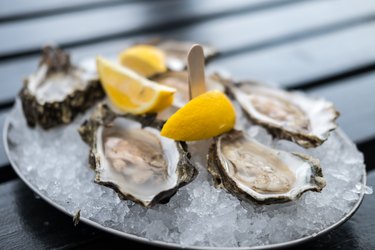
There are many scares associated with storing oysters and other shellfish, primarily because they are sometimes eaten raw. If your oysters were properly harvested from approved waters, then all you need to worry about is keeping them at low temperatures and consuming them sooner rather than later. Live oysters in the shell are stored differently than freshly shucked oysters, and care should be taken to note the difference so that you can consume the delicacy without fear of shellfish poisoning.
Storing Live Oysters
Video of the Day
Live in-shell oysters can be stored longer than shucked oysters, so if you are confident and have the proper shucking tools, buying fresh in-shell oysters is the best way to guarantee freshness. To keep oysters alive, they must be stored so that they can breath. Never store them in airtight containers.
Video of the Day
The best way to keep oysters fresh is to line the oysters flat-side up on a large tray or baking sheet and cover with a damp cloth or damp paper towel. Do not store them in cold water, as oysters die in fresh water. Keep them in the refrigerator at 36 to 40 degrees Fahrenheit. If the temperature 35 degrees or lower, the oysters will die. If you harvested the oysters yourself, make sure you get them in the refrigerator within 1 1/2 hours after harvesting. (Always harvest oysters from safe and approved waters; check with local laws and warnings before harvesting shellfish.) Consume the live oysters within 1 to 2 days for best results, but if kept cool they can last up to a week.
Determining if Oysters Are Dead
Discard any oysters that have died during storage. Dead oysters are riddled with dangerous bacteria and should never be eaten, even if you plan to cook them.
You will know that an oyster is dead if you tap on the shell (with a knife or hard object) and it does not react. A live oyster will retract and close the shell very tightly. If it doesn't retract, it is dead. If the shell is closed before you tap it, the oyster may be dead. You will know if it is dead because it will make a very distinct hollow sound opposed to the others, these are known as "clackers" and should be discarded.
How to Shuck Oysters
Shuck oysters ahead of time if time is short on the day you plan to enjoy the tasty mollusks. Use a hand towel to protect your hand and hold the oyster firmly. With the other hand, insert the point of the shucking knife into the shell, at the hinge. Press inward and twist to lever the shell open. Once you've popped the shell open, remove the oyster by sliding the knife under it to release it from the shell. Refrigerate or enjoy immediately with your favorite sauce or dressing.
Storing Shucked Oysters
For shucked oysters, unlike live ones, colder is better. Set your refrigerator between 34 and 35 degrees and store oysters in an airtight container or covered bowl. Shucked oysters will stay fresh at cold temperatures for 4 to 5 days. If you purchased shucked oysters in a container, keep only until the expiration date printed on the container.
Freezing Fresh Oysters
Keep oysters on ice or freeze them. Freezing shucked oysters will allow you to store them for the longest period of time. Freeze only high-quality oysters, and never freeze in-shell oysters or dead oysters. To store freshly shucked oysters, place in an air-tight, freezer-quality storage container at 0 degrees Fahrenheit or lower to ensure that the oysters will not degrade. Thaw inside the refrigerator overnight. Do not thaw at room temperature or in the sink.